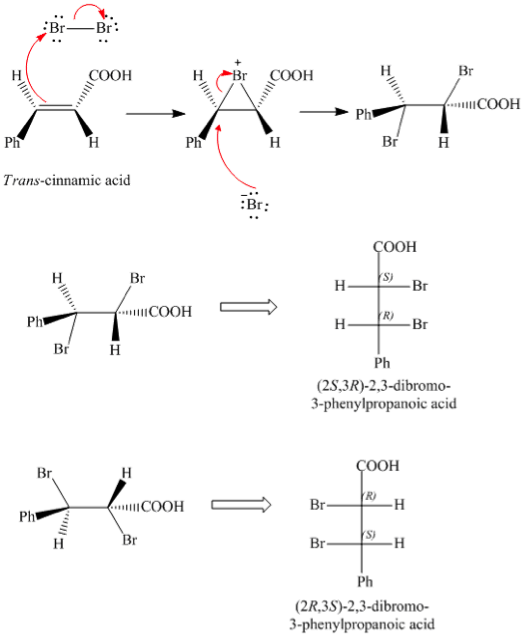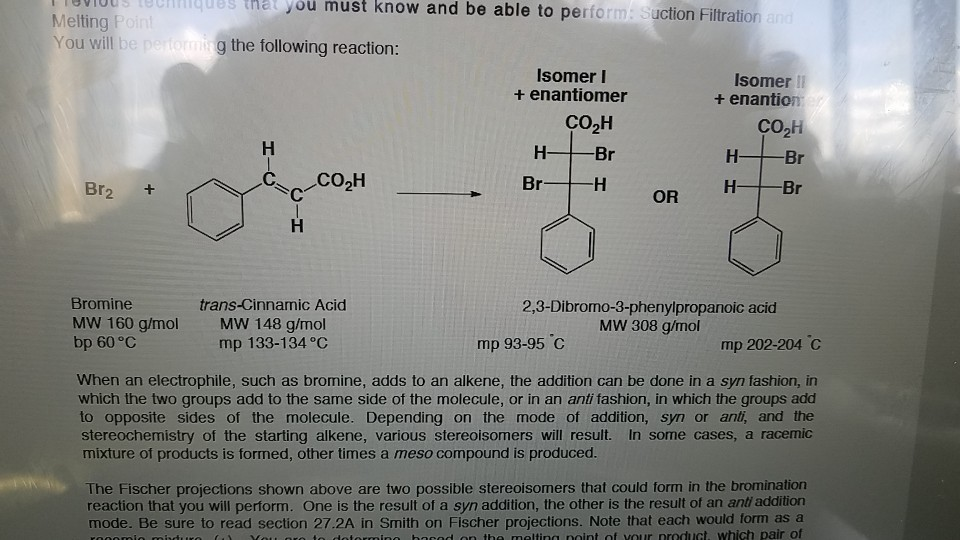Melting Point of Syn and Anti Addition
Addition and the other is the result of an. Since there is no plane or point of symmetry a Meso compound can not be formed For a symmetrical alkene where.
What Is The Difference Between Syn And Anti Addition In Organic Chemistry Quora
Despite the errors according to the book erythron-23.

. Determination of the Stereochemistry of 23-dibromo-3-phenylpropanoic acid. This is the main difference between syn and anti addition. In this experiment the stereochemistry of 23-dibromo-3-phenylpropanoic was found to determine syn or anti addition of bromines.
In the case that there is a mixture of both products the melting range can be expected to be an average of the syn and anti periplanar melting ranges therefore 147-149. Determining the Percent Yield CC Ph H H CO 2H Br 2 CH 2Cl 2 C C O 2H H Br H Br Ph MW 14816 C 9H 8O 2. The measurement of the melting point allows determining the addition mode of the bromine to the double bond.
Furthermore it eliminated the possibility of the product being a syn-addition product 95. Describe the melting range for each scenario Is the melting point you recorded consistent with one particular stereoisomer of the. If the melting point is around 200-205C then the addition occurred via syn-addition.
Because the melting points of erythro- and threo- dibromides differ by more than 100 deg C the product can be easily identified by its melting point. Connecting the Physical Data with the Mechanism. Accomplish this goal I carried out the bromination of trans-cinnamic acid in.
So we know that it is either the syn or the anti addition. Carry out the bromination of trans-cinnamic acid determine the stereochemistry of the dibromide and find out whether the reaction proceeds by the usual bromonium ion mechanism or a different one. The melting point was 199-203C and the NMR J values angle is at 167 which both prove the erythro-23-dibromo-3-phenylpropanoic.
A majority syn-addition b. The melting point of your product should enable you to determine whether the product is a racemic mixture of the erythro or the threo stereoisomers or a mixture of diastereomers. Anti vs syn addition.
What was the goal of experiment 23 1. You are to determine based on the melting point of your product which pair of enantiomers is produced. D We are able to determine how the addition occurred based on melting point as diastereomers possess different melting points.
Syn addition is the addition of two substituents to the same side of the unsaturated molecule. By knowing which enantiomeric pair is formed one can predict a plausible mechanism. You should show that syn andor anti addition leads to a 5050 mixture of enantio mers.
An equal mixture of both syn- and anti-addition. Syn represents the cis position of the hydroxyl group with respect to the hydrogen group whereas in anti trans position is observed. Anti adding components to opposite sides of the CC double bond.
If the melting point is around 93-95C then the addition occurred via syn. This could have been a result of the product being left in the flask or errors during the recrystallization process. SYN and ANTI ADDITION.
Acid only adds by syn-addition only adds by anti-addition or if both products are produced. There are three possible types of mixtures here such as syn as the major product and anti as the minor etc. For example Butane and isobutane have the same number of.
The values obtained confirm the erythro configuration of the product resulting from an anti addition. Based on the melting point of the product determine whether the threo 8 or erytho diastereomers formed from this reaction. Although the precent yield of the experiment was 77 meaning 22 of the product was lost.
But directly it comes from the deamination of the amino acid phenylanaline. The melting point was 199-203C and the NMR J values angle is at 167 which both prove the erythro-23-dibromo-3-phenylpropanoic. In this experiment the stereochemistry of 23-dibromo-3-phenylpropanoic was found to determine syn or anti addition of bromines.
The theoretical melting point range was 2034-2056 o C 2027-2053 o C therefore telling that the product formed was erythro-23-dibromo-3-phenylpropanoic acid since the melting point values recovered was close to 202-204C value. In the case of a asymmetrical alkene any type of addition will result in enantiomers and hence a racemic mixture. The problem I am having is that after the double bond is broken the molecule is free to rotate which should allow for a 5050 split.
ANTI SYN and ANTI. Determination of the Stereochemistry of 23-dibromo-3-phenylpropanoic acid. C C Ph H H CO 2H Br Br C C Ph H CO 2H H Br Br C C Ph H CO.
From this information you should be able to conclude whether the reaction proceeded by syn or anti. For an anti periplanar product the melting range is expected to be from 202-204 degrees Celsius. Anti addition on the other hand is the addition of two substituents in opposite directions.
The product that was obtained is 2S3R-23-dibromo-3-phenyl propanoic acid and the identity of the product can be confirmed through the melting range. A majority anti-addition or c. One is the result of a syn addition the other is the result of an anti addition mode.
The results indicate that the melting point range of the product was between 198 degrees Celsius and 200 degrees Celsius. Note that each would form as a racemic mixture. Answer 1 of 2.
We got melting of the 200 C. If the melting point is around 93-95C then the addition occurred via anti-addition. For example Structural isomers are those in which the molecules have the same molecular formula but their atoms have different arrangements or bonds.
This experiment is very reproducible and was performed with students of the first year of the Chemistry degree. Describe the melting point you expect to observe if the isolated product is the mixture of both syn and anti addition of bromine. Note that each would form as a racemic mixture.
This did not appear to happen So maybe there is something in the solution that keeps the bond from rotating. You are to determine based on the melting point of your product whether one of the pairs of enantiomers is produced or if there is a 11 mixture of the two. These addition reactions alter the bond order of the reactant molecule as well as the number of.
In the case that the product is syn periplanar the melting range is expected to be 935-950 degrees Celsius. Explain how this observation about the bromine addition to trans-cinnamic acid products supports either a. Anti-addition using an onium ion intermediate or in a mixture of both additions t hrough a benzylic.
A mixture of both products would melt over. The reason for such a high yield was due to substance not being fully dried when weighing most likely. The melting range that was obtained was from 199- 201 C which is very close to the melting range of the anti-addition product 202-204 C.

Solved Draw The Overall Reaction Including Stereochemistry Chegg Com

Syn Anti Addition In Stereochemistry Mechanism Reactions Examples Video Lesson Transcript Study Com

Solved Based On The Results What Product Would You Expect Chegg Com
Comments
Post a Comment